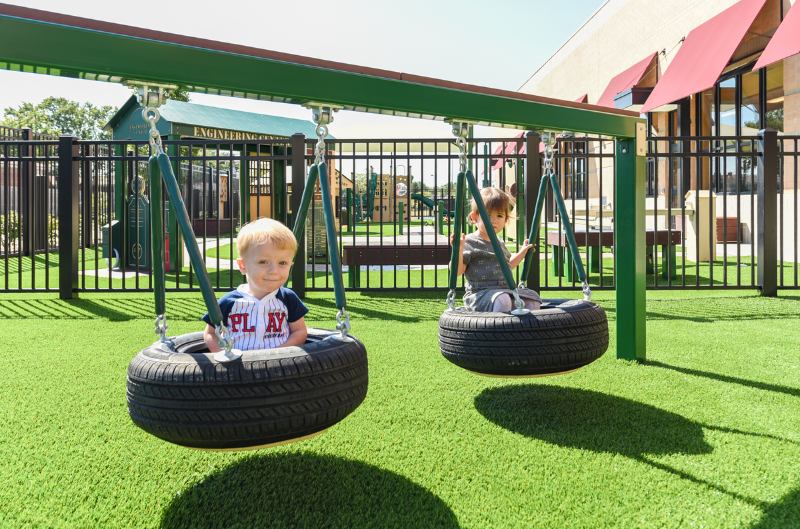
Breaking Barriers: How to Encourage Disability Awareness in Play Spaces
Author: Austin Stanfel
Playgrounds are more than just spaces for children to burn off energy; they are vibrant hubs for social interaction, physical activity, and personal growth. However, these spaces often lack the inclusivity necessary to ensure that children with disabilities can fully participate and thrive. By fostering disability awareness, playgrounds can become more than just places to play—they can become platforms for education, empathy, and community building. Here is an in-depth exploration of how to promote disability awareness on the playground and create genuinely inclusive play environments.
Why Disability Awareness Matters on the Playground
Playgrounds are key social environments where children learn critical life skills like cooperation, empathy, and conflict resolution. However, for children with disabilities, these spaces can sometimes highlight barriers rather than opportunities. Raising disability awareness ensures that:
Children Feel Valued: Regardless of ability, all children deserve to feel included and respected.
Peers Develop Empathy: Interacting with diverse abilities helps children understand and respect differences.
Communities Become Inclusive: Playgrounds can serve as a microcosm of society, setting the tone for acceptance and inclusivity in the broader world.
Promoting awareness is about adding equipment and fostering a mindset of inclusivity and mutual respect.
Designing Inclusive Play Spaces
Inclusive playground design is the first step in promoting disability awareness. Thoughtful design ensures accessibility while encouraging interaction between children of all abilities. Key elements include:
Accessible Equipment: Install ramps, wheelchair-accessible swings, and transfer platforms so children with mobility challenges can enjoy the fun.
Sensory Features: To engage children with sensory processing differences, include tactile panels, musical instruments, and visual elements.
Quiet Spaces: Create areas where children can take a break if they feel overwhelmed, catering to neurodivergent children needing time to reset.
Universal Design Principles: Go beyond compliance with the Americans with Disabilities Act (ADA) by designing spaces welcoming to all, regardless of ability.
Inclusive design communicates a clear message: Everyone is welcome here.
Encouraging Peer Advocacy
Children are naturally empathetic when given the tools to understand and include others. Encouraging them to become advocates for inclusion helps build lasting connections and a culture of acceptance. Strategies include:
Inclusive Play Leaders: Train children to be “play ambassadors” who actively involve peers with disabilities in games and activities.
Storytelling and Role-Playing: Use books and scenarios to teach children how to empathize with and support peers with disabilities.
Celebration of Differences: Organize events or activities highlighting every child’s strengths and unique abilities, fostering a positive view of diversity.
When children learn to advocate for inclusion, they carry those values into adulthood, creating a ripple effect of awareness.
Supporting Adults in Inclusive Play
Playground supervisors, caregivers, and teachers are essential in fostering an inclusive environment. Adults can:
Model Inclusivity: Demonstrate inclusive behavior by interacting with all children equally and encouraging group participation.
Facilitate Interaction: Introduce children to one another and suggest activities that include everyone.
Address Bullying or Exclusion: Intervene when exclusionary behavior arises and gently guide children toward inclusive alternatives.
Provide Positive Reinforcement: Praise children who demonstrate kindness and teamwork, reinforcing inclusive behaviors.
Training sessions for supervisors can ensure they are equipped to handle diverse needs and create a welcoming environment.
Integrating Technology for Inclusive Play
Technology has opened up new possibilities for making playgrounds more inclusive and engaging. Here are some ways technology can enhance disability awareness:
Interactive Panels: Digital panels with touch, sound, and visual features can engage children with sensory, auditory, or visual disabilities.
Augmented Reality (AR): AR apps can provide guided experiences that educate children about disabilities while enhancing play.
Assistive Devices: Provide voice amplification systems, communication boards, or other assistive tools to support children with speech or hearing impairments.
Integrating technology ensures that playgrounds remain innovative and inclusive for all users.
Hosting Disability Awareness Events
Special events focused on disability awareness can transform playgrounds into educational spaces. Ideas for events include:
Inclusion Days: Dedicate a day to celebrating diversity, featuring games, activities, and guest speakers who discuss disabilities and inclusion.
Adaptive Sports Clinics: Allow children to try wheelchair basketball, goalball, or other adaptive sports.
Community Art Projects: Collaborate on murals or sculptures that celebrate inclusion, allowing children of all abilities to contribute.
Storytime Sessions: Invite authors or storytellers to share books that promote disability awareness and inclusion.
These events educate and create lasting memories and stronger community bonds.
Engaging the Broader Community
Raising disability awareness requires the involvement of the entire community. Collaborative efforts can amplify the impact of your initiatives. Suggestions include:
Partnering with Organizations: Work with disability advocacy groups, schools, and local businesses to fund and promote inclusive projects.
Educational Signage: Install signs around playgrounds explaining the purpose of inclusive features and offering tips on fostering inclusion.
Social Media Campaigns: Share stories, photos, and videos highlighting inclusive play to reach a wider audience and inspire change.
Community engagement ensures that disability awareness becomes a shared responsibility.
Addressing Intersectionality
Disability does not exist in isolation—it intersects with other identities such as race, gender, and socioeconomic status. Inclusive playground initiatives should:
Acknowledge Diverse Needs: Ensure that playground designs and programs consider children from marginalized communities’ unique challenges.
Collaborate with Diverse Groups: Partner with organizations focusing on racial equity, LGBTQ+ inclusion, and economic justice.
Provide Affordable Options: Ensure playgrounds are accessible to low-income families through grants or community funding.
By addressing intersectionality, playgrounds can serve as inclusive spaces for all children.
Measuring Success and Sustainability
Tracking the impact of disability awareness initiatives helps ensure continuous improvement.
Key metrics include:
Feedback Surveys: Collect input from parents, children, and supervisors to gauge satisfaction and identify areas for improvement.
Observation: Monitor interactions on the playground to assess inclusivity and identify any barriers.
Community Meetings: Host forums to discuss progress, gather suggestions, and share success stories.
Regular assessment ensures that your initiatives remain effective and impactful over time.
Building a Culture of Inclusion
Promoting disability awareness on the playground is more than adding ramps or sensory panels. It is about fostering a culture where every child feels valued and supported. By combining thoughtful design, educational initiatives, and community collaboration, playgrounds can become powerful spaces for learning, connection, and growth.
With these efforts, we can ensure that playgrounds genuinely live up to their potential as places where every child—regardless of ability—can play, learn, and belong.

